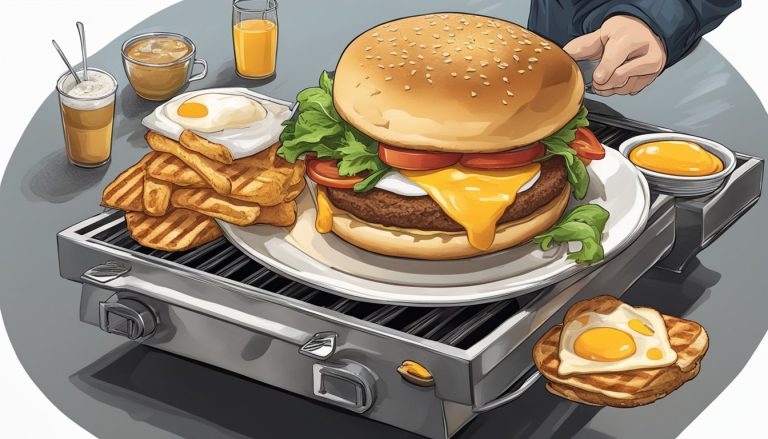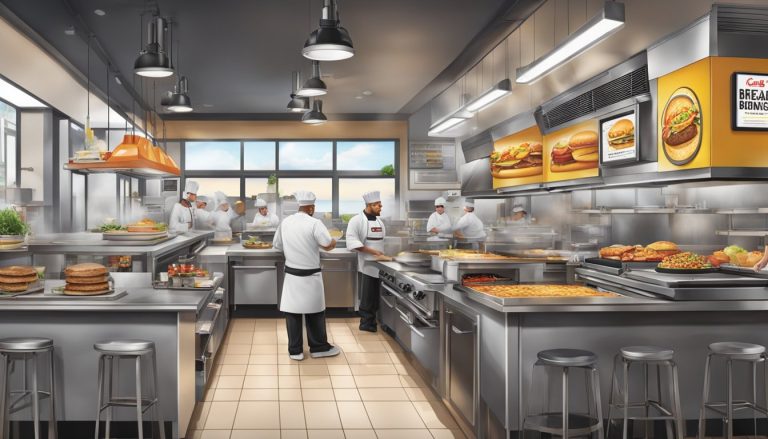Carl’s Jr., a prominent fast-food chain in California, has made significant strides in the coffee market. The restaurant’s journey into the world of caffeinated beverages began with the introduction of their Iced Coffee in 2015. This initial offering featured a cold brew with French vanilla notes and a hint of salt, catering to the growing demand for chilled coffee options.
Building on the success of their Iced Coffee, Carl’s Jr. expanded their coffee lineup in 2019 with the launch of their Vanilla Cold Brew. This new addition to the menu uses a light roast coffee that is steeped to perfection, resulting in a smooth and refreshing drink with a subtle vanilla flavor. The Vanilla Cold Brew quickly became a popular choice among coffee enthusiasts looking for a convenient caffeine fix on the go.
Carl’s Jr.’s foray into the coffee market reflects a broader trend in the fast-food industry, with many chains expanding their breakfast offerings to include premium coffee options. By providing affordable and easily accessible coffee drinks, Carl’s Jr. has positioned itself as a viable alternative to traditional coffee shops for busy customers seeking their morning brew.
The Origins of Carl’s Jr.
Carl’s Jr. began as a modest hot dog stand in Los Angeles and grew into a major fast food chain. Its success stems from founder Carl Karcher’s entrepreneurial drive and willingness to take risks in the restaurant industry.
From Humble Beginnings to Fast Food Chain
In 1941, Carl Karcher and his wife Margaret purchased a hot dog cart in Los Angeles for $311. This small investment marked the beginning of what would become Carl’s Jr. The cart proved successful, leading Karcher to buy several more stands.
By 1945, the couple opened their first full-service restaurant, Carl’s Drive-in Barbecue, in Anaheim. The restaurant’s popularity in Southern California paved the way for expansion.
In the 1950s, Karcher launched smaller versions of his original restaurant. These streamlined outlets became known as Carl’s Jr., a name reflecting their relation to the larger Carl’s Drive-in Barbecue.
Carl Karcher’s Entrepreneurial Spirit
Carl Karcher’s business acumen and willingness to innovate drove Carl’s Jr.’s growth. He recognized changing consumer preferences and adapted his menu accordingly.
Karcher introduced self-serve salad bars to his restaurants in 1977, ahead of competitors. This move helped Carl’s Jr. stand out in the fast food landscape.
His commitment extended beyond business. Karcher was known for his strong faith, attending mass daily before starting work at 7 am. This discipline likely contributed to his success in building Carl’s Jr. into a major fast food chain.
Evolution of Carl’s Jr. Menus

Carl’s Jr. has undergone significant menu transformations since its inception. The chain expanded from a humble hot dog cart to a fast-food powerhouse known for bold flavors and hefty portions.
Advent of Charbroiled Hamburgers
Carl’s Jr. made its mark with the introduction of charbroiled hamburgers in the 1960s. This cooking method gave their burgers a distinctive smoky flavor and crispy exterior. The charbroiling process became a cornerstone of the brand’s identity.
The Original Six Dollar Burger debuted in 2001, featuring a 1/3 pound patty. It aimed to offer a restaurant-quality burger at a fast-food price point. This item helped solidify Carl’s Jr.’s reputation for premium, indulgent offerings.
Introduction of Breakfast Items
Carl’s Jr. entered the breakfast market in the 1970s. The menu featured classics like eggs, bacon, and hash browns. Biscuits became a staple, with options like the Made from Scratch Biscuits introduced later.
French Toast Dips arrived in 2011, offering a handheld twist on a breakfast favorite. These portable items catered to on-the-go customers seeking quick morning meals.
Expanding Beyond Burgers and Burritos
While burgers remained the focus, Carl’s Jr. diversified its menu over time. The chain added chicken sandwiches, salads, and sides to appeal to a broader audience.
Burritos and other Mexican-inspired items appeared on the menu, though with mixed success. The brand’s attempts at Mexican food spin-offs ultimately ended in failure.
In 2011, Carl’s Jr. became the first national chain to offer turkey burgers. This move aimed to attract health-conscious consumers while maintaining the brand’s indulgent image.
Coffee and the Breakfast Revolution

Carl’s Jr. transformed the morning meal landscape by making coffee a centerpiece of their breakfast offerings. This shift reshaped customer expectations and menu options across the fast food industry.
Coffee as a Key Component of Breakfast
Carl’s Jr. recognized coffee’s importance in jumpstarting the day. They invested in high-quality beans and brewing methods to create a signature blend that paired perfectly with their breakfast items.
The chain introduced larger cup sizes and flavor options to cater to diverse preferences. Free refills became standard, encouraging customers to linger and potentially order more food.
Carl’s Jr. also launched a loyalty program centered around coffee purchases, incentivizing repeat visits during breakfast hours.
Signature Breakfast Items
Carl’s Jr. developed unique breakfast offerings to complement their coffee. The Breakfast Burger became an instant hit, combining a beef patty with egg, bacon, and cheese on a bun.
The Monster Biscuit appealed to hearty appetites with its stack of eggs, bacon, sausage, and cheese. For a twist on tradition, Carl’s Jr. introduced the Grilled Cheese Breakfast Sandwich.
Breakfast Burritos joined the menu, packed with eggs, cheese, and various meats. The Loaded Breakfast Burrito became particularly popular for its generous portions and bold flavors.
The Rise of All-Day Breakfast Options
Responding to customer demand, Carl’s Jr. extended breakfast hours beyond traditional morning timeframes. This move allowed them to capture late-rising customers and those craving breakfast foods later in the day.
Select breakfast items became available all day, with the Breakfast Burger often leading this category. The chain also experimented with hybrid menu items that blended breakfast and lunch elements.
Carl’s Jr. adjusted their kitchen operations to accommodate simultaneous preparation of breakfast and regular menu items throughout the day. This flexibility helped them stay competitive in the evolving fast food landscape.
Strategic Moves and Innovation

Carl’s Jr. has made bold choices to reinvigorate its breakfast offerings and appeal to changing consumer tastes. The company has focused on expanding menu options, embracing plant-based alternatives, and enhancing the overall morning dining experience.
Expanding Breakfast Options
Carl’s Jr. recognized the growing demand for all-day breakfast options. In response, the chain extended its breakfast hours, allowing customers to enjoy morning favorites well into the afternoon. This move tapped into the comfort food trend, satisfying cravings for hearty breakfast items at any time of day.
The expanded menu now includes a wider variety of egg dishes, breakfast sandwiches, and breakfast burritos. Carl’s Jr. also introduced healthier alternatives like oatmeal and fruit parfaits to cater to health-conscious consumers.
These additions have helped Carl’s Jr. compete more effectively in the crowded fast-food breakfast market.
Partnering with Beyond Meat
In a forward-thinking move, Carl’s Jr. teamed up with Beyond Meat to offer plant-based options on its breakfast menu. This partnership addressed the rising demand for meat alternatives among consumers.
The Beyond Breakfast Sausage Burrito and Beyond Sausage Egg & Cheese Biscuit became popular choices. These items appeal to vegetarians, flexitarians, and curious meat-eaters alike.
By embracing plant-based proteins, Carl’s Jr. positioned itself as an innovative player in the fast-food industry. This strategy aligns with growing environmental and health concerns among consumers.
Revamping the Breakfast Experience
CKE Restaurants, Carl’s Jr.’s parent company, invested in modernizing the breakfast experience across its locations. This included upgrading kitchen equipment to improve food quality and consistency.
The chain also redesigned its breakfast packaging to enhance visual appeal and maintain food temperature. New coffee blends were introduced to compete with specialty coffee shops.
Carl’s Jr. launched a mobile app with exclusive breakfast deals and a rewards program. This digital integration aimed to increase customer loyalty and streamline the ordering process.
These improvements collectively transformed Carl’s Jr.’s breakfast offering into a more premium experience, helping the chain stand out in a competitive market.
Business Practices and Corporate Identity

Carl’s Jr. has developed a distinct corporate identity through its marketing strategies and business practices. The company’s approach to growth and operations has shaped its image in the fast food industry.
Headquarters: Driving the Brand Forward
Carl’s Jr.’s corporate headquarters is located in Franklin, Tennessee. This central hub oversees the company’s operations, marketing initiatives, and strategic planning. The headquarters plays a crucial role in shaping the brand’s direction and maintaining consistency across its franchises.
CKE Restaurant Holdings, Inc., the parent company of Carl’s Jr., moved its headquarters from California to Tennessee in 2017. This relocation was part of a broader strategy to streamline operations and reduce costs. The move also brought Carl’s Jr. closer to its sister brand, Hardee’s, which has a strong presence in the Southeastern United States.
Tackling the Challenges: Legal and Ethical
Carl’s Jr. has faced its share of legal and ethical challenges over the years. The company has dealt with issues ranging from labor disputes to marketing controversies. In 2004, Carl’s Jr. settled a class-action lawsuit regarding overtime pay for managers in California.
The brand’s provocative advertising campaigns have sometimes drawn criticism for their portrayal of women. Carl’s Jr. has since shifted its marketing focus to emphasize food quality and innovation. The company has also implemented policies to address workplace issues and promote ethical business practices.
Insider trading has not been a significant issue for Carl’s Jr. or its parent company. However, like all public companies, CKE Restaurant Holdings is subject to SEC regulations regarding insider trading.
Market Position and Competition

Carl’s Jr. occupies a unique position in the fast-food landscape, competing with both traditional burger chains and newer fast-casual concepts. The brand’s identity and market strategy have evolved significantly since its inception.
Carl’s Jr. Versus Hardee’s: Distinct Identity
Carl’s Jr. and Hardee’s operate under the same parent company but maintain separate brand identities. Carl’s Jr. primarily serves the western United States, while Hardee’s dominates in the East. Despite shared ownership, each chain has distinct menu offerings and marketing approaches.
Carl’s Jr. focuses on big, bold flavors and innovative menu items. The brand targets a younger demographic with edgier marketing campaigns. Hardee’s, in contrast, maintains a more traditional fast-food image, appealing to a broader audience with classic American fare.
Rivalry Within The Fast-Food Arena
Carl’s Jr. faces stiff competition from established fast-food giants and emerging fast-casual brands. The chain competes directly with burger-focused chains like McDonald’s, Burger King, and Wendy’s.
To differentiate itself, Carl’s Jr. emphasizes premium ingredients and larger portion sizes. The brand has introduced unique menu items like the Beyond Burger to appeal to health-conscious consumers and vegetarians.
In the fast-casual space, Carl’s Jr. contends with brands like Five Guys and Shake Shack. These competitors offer higher-quality burgers at slightly higher price points. Carl’s Jr. strives to balance quality and affordability to maintain its market position.
Nutrition and Consumer Health

Carl’s Jr. offers a range of menu items with varying nutritional profiles. The company has made efforts to provide options for health-conscious customers while maintaining its indulgent offerings.
Addressing Healthier Options
Carl’s Jr. introduced turkey burgers as a leaner alternative to their traditional beef patties. These burgers contain fewer calories and less fat than their charbroiled counterparts. The chain also offers salads for those seeking lighter fare.
Some locations feature salad bars, allowing customers to customize their greens and toppings. This option provides more control over portion sizes and nutritional content.
Carl’s Jr.’s coffee contains relatively few calories. A medium-sized regular coffee has only 15 calories, making it a low-calorie beverage choice for customers watching their intake.
Balancing Flavor and Nutrition
While Carl’s Jr. is known for its indulgent Thickburgers, the company has worked to balance flavor with nutritional considerations. They offer grilled chicken options and lettuce-wrapped burgers for carb-conscious diners.
The chain provides detailed nutritional information for all menu items. This transparency allows customers to make informed choices based on their dietary needs and preferences.
Carl’s Jr. uses a charbroiling method for their burgers, which can help reduce fat content compared to pan-frying. However, many menu items still contain high levels of calories, fat, and sodium. Customers should consider portion sizes and frequency of consumption when including these foods in their diets.




